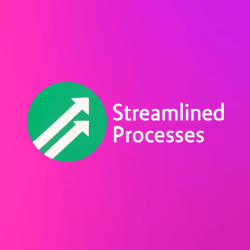For Optimized Team Workflows, see our main page here.
What Do Optimized Team Workflows Really Mean?
Optimized Team Workflows involve improving how teams collaborate, communicate, and complete tasks. It’s more than just assigning duties—it’s about creating a seamless system where every action supports overall goals. When workflows are aligned with business needs, productivity increases, errors drop, and job satisfaction improves.
Take tech startups for example. Many use Agile and Scrum to streamline decisions and adapt quickly to changes. These methods empower teams to iterate faster, prioritize user feedback, and reduce turnaround time. Likewise, law firms use case management systems to handle client files, schedule dates, and automate document generation. These industry-specific systems make workflows more efficient without sacrificing compliance.
Key Components of Optimized Team Workflows
Every winning workflow includes these critical parts:
- Clear roles and responsibilities: Everyone must know their purpose and who to turn to for support.
- Defined processes: Avoid reinventing the wheel. Clear steps cut confusion and set expectations.
- Automation tools: Tasks like approvals, scheduling, or data entry can be automated, saving time.
- Collaborative platforms: Teams need a digital “home” to track projects, share files, and chat.
- Regular check-ins: Weekly huddles and retrospective reviews help you course correct and improve.
When these factors are consistently applied, Optimized Team Workflows naturally take shape.
Popular Tools That Support Team Flow
Choosing the right tools can make or break your workflow. Fortunately, many options cater to different team sizes and goals.
- Asana and Trello: These platforms handle task assignment, due dates, and project overviews.
- Slack and Microsoft Teams: Enable real-time communication, file sharing, and integration with other tools.
- Zapier: Automates workflows between apps like Gmail, Slack, and Google Sheets.
- ClickUp: Combines docs, tasks, and goals into one view for easier decision making.
For example, marketing agencies often connect Google Calendar, Slack, and Zoom via Zapier. This allows for auto-scheduling meetings, sharing reminders, and syncing deliverables—without repetitive manual steps.
Barriers to Workflow Optimization
Disjointed systems, unclear priorities, and lack of feedback loops are major obstacles. Teams that don’t review their routines fall into bad habits that lead to missed deadlines and misunderstandings.
Technical debt is another hidden threat. If your team relies on outdated software or ad hoc tools, small inefficiencies can snowball. On the other hand, frequent changes without training also cause anxiety and confusion. Change management plays a vital role in repeating Optimized Team Workflows across departments.
To clarify, tools alone won’t optimize your workflow. Culture and leadership buy-in matter just as much.
How to Implement Optimized Team Workflows Step-by-Step
To succeed, take these practical steps:
- Audit your current workflows: Interview team members and record how work flows from start to finish.
- Map the ideal process: Consider efficiency, accountability, and alignment with goals.
- Select the right tools: From project tracking to collaboration, tools should feel intuitive for the team.
- Train and test: Provide training sessions and test new workflows before scaling.
- Measure outcomes: Use KPIs like turnaround time, team satisfaction, and project velocity.
For example, a healthcare administrative team replaced slow Excel-based approvals with an automated Google Forms system connected to Slack channels. Approval time dropped by 60%, and missing signatures became rare.
Company Culture’s Role in Optimized Team Workflows
Workflows are a reflection of company values. Therefore, when transparency, autonomy, and continuous learning are part of your culture, workflow improvements stick.
For instance, tech company Buffer publicly shares salaries, meetings, and internal decisions. This open culture supports fast decision-making and fewer roadblocks. Similarly, Amazon uses the “6-pager” memo system to clarify thinking before any big meeting—an approach that puts process at the core of execution.
Case Study: Optimizing Remote Work Collaboration
After switching to full remote work, a design firm faced missed deadlines and overlapping work. They introduced an updated workflow using Monday.com and Figma comments.
Here’s what changed:
- Tasks were assigned with clear owners and due dates.
- Client feedback was centralized via Figma.
- Weekly Zoom retrospectives highlighted blockers and wins.
Within six months, on-time project delivery increased by 35%. Clients reported faster turnaround, and internal satisfaction scores improved by 42%.
Trends Shaping the Future of Team Workflows
As more teams embrace hybrid or remote models, workflow optimization becomes essential, not optional. Companies are investing in AI, automation, and agile management to remain competitive.
According to Gartner, by 2027 over 70% of teams will rely on AI-assisted decision-making. Tools like Notion AI and Microsoft Copilot already help with task planning and documentation.
In the same vein, workflow orchestration is moving from static SOPs to flexible, data-driven processes. Tools now suggest next steps, analyze performance, and recommend improvements in real time.
This means teams can shift from reactive to proactive modes of working, setting the stage for true Optimized Team Workflows.
Q&A: Common Questions About Optimized Team Workflows
Q: How do I know if my workflows need optimization?
A: Look for signs like high error rates, delays, unclear responsibilities, or inconsistent results. Conducting a workflow audit is the best first step.
Q: How long does it take to see results?
A: Small improvements yield results within weeks. However, full optimization with new tools and habits may take 3–6 months depending on team size.
Q: Should we use one tool or many?
A: Start with as few tools as possible. Integrate only what fills a gap. Many platforms play well together through APIs or connectors.
Q: Is automation always required?
A: No. While helpful, automation is not a must. Human-driven workflows can still be optimized by clarifying steps and responsibilities.
In Conclusion: Building Smarter, Faster Teams
Optimized Team Workflows transform the way people work together. They reduce chaos, boost morale, and improve outcomes. Tools and templates help, but the mindset to evolve and improve continuously is what delivers lasting success.
This article was created with the assistance of AI tools and reviewed by our team at Streamlined Processes LLC to ensure accuracy and relevance.
Follow us on Facebook here.

